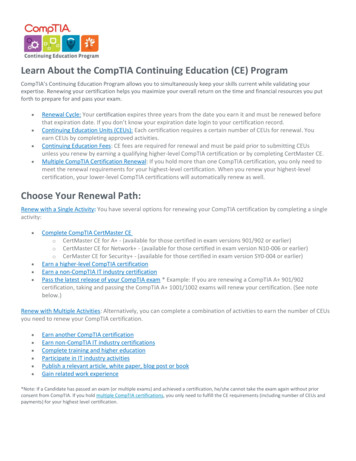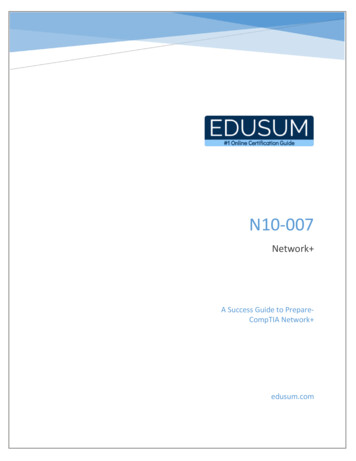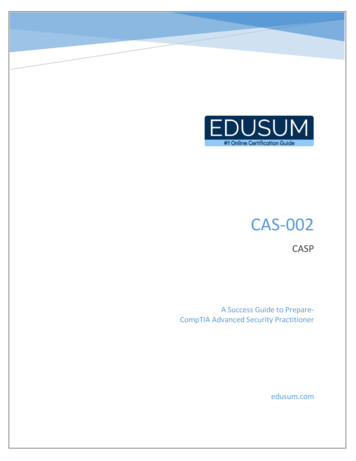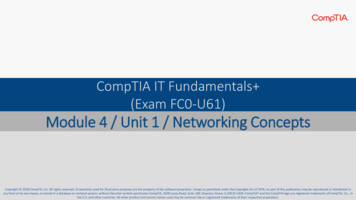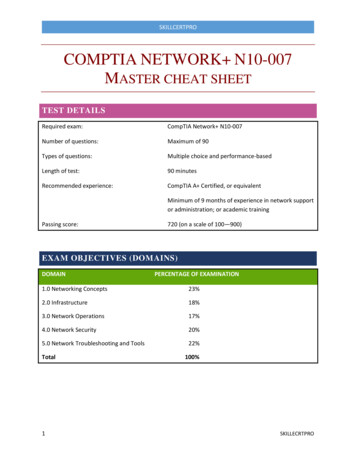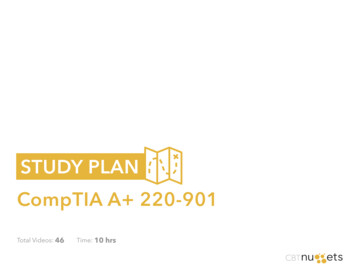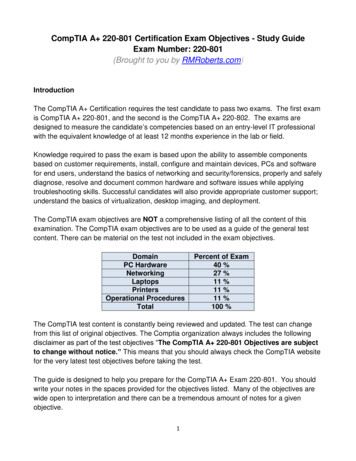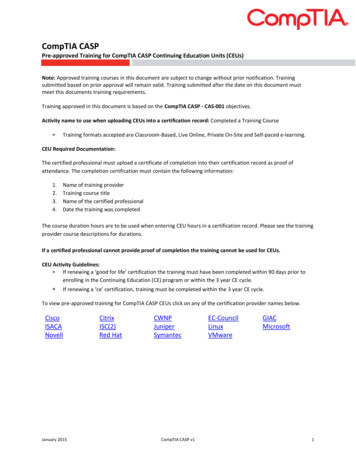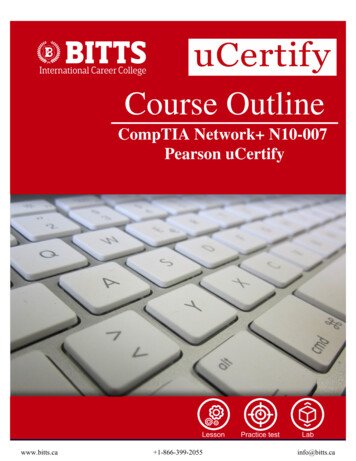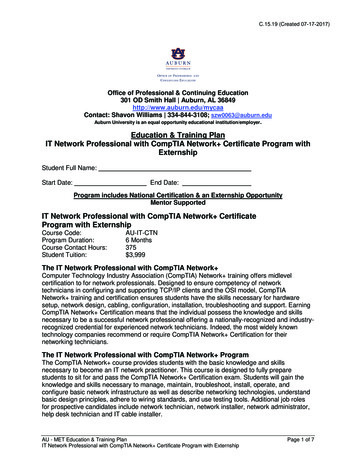
Transcription
C.15.19 (Created 07-17-2017)OHICE OF P ROFESSIONAL ANDCONTINUING EDUCAT I ONOffice of Professional & Continuing Education301 OD Smith Hall Auburn, AL 36849http://www.auburn.edu/mycaaContact: Shavon Williams 334-844-3108; szw0063@auburn.eduAuburn University is an equal opportunity educational institution/employer.Education & Training PlanIT Network Professional with CompTIA Network Certificate Program withExternshipStudent Full Name:Start Date:End Date:Program includes National Certification & an Externship OpportunityMentor SupportedIT Network Professional with CompTIA Network CertificateProgram with ExternshipCourse Code:Program Duration:Course Contact Hours:Student Tuition:AU-IT-CTN6 Months375 3,999The IT Network Professional with CompTIA Network Computer Technology Industry Association (CompTIA) Network training offers midlevelcertification to for network professionals. Designed to ensure competency of networktechnicians in configuring and supporting TCP/IP clients and the OSI model, CompTIANetwork training and certification ensures students have the skills necessary for hardwaresetup, network design, cabling, configuration, installation, troubleshooting and support. EarningCompTIA Network Certification means that the individual possess the knowledge and skillsnecessary to be a successful network professional offering a nationally-recognized and industryrecognized credential for experienced network technicians. Indeed, the most widely knowntechnology companies recommend or require CompTIA Network Certification for theirnetworking technicians.The IT Network Professional with CompTIA Network ProgramThe CompTIA Network course provides students with the basic knowledge and skillsnecessary to become an IT network practitioner. This course is designed to fully preparestudents to sit for and pass the CompTIA Network Certification exam. Students will gain theknowledge and skills necessary to manage, maintain, troubleshoot, install, operate, andconfigure basic network infrastructure as well as describe networking technologies, understandbasic design principles, adhere to wiring standards, and use testing tools. Additional job rolesfor prospective candidates include network technician, network installer, network administrator,help desk technician and IT cable installer.AU - MET Education & Training PlanIT Network Professional with CompTIA Network Certificate Program with ExternshipPage 1 of 7
C19 (Created 09/03/15)Education and National Certifications Students should have or be pursuing a high school diploma or GED. There are no state approval and/or state requirements associated with this program. There are several National Certification exams that are available to students whosuccessfully complete this program: CompTIA Network (N10-005) Certification Exam from CompTIA Microsoft Office Specialist (MOS) Certification Exam.Program ObjectivesAt the conclusion of this program, students will be able to: Summarize DNS concepts and its components, and increasingly converged networks Explain network structure, end and intermediate devices, and the interconnecting media Distinguish between circuit-switched and packet-switched communications Describe the role of addressing and naming in network communications Explain the purpose and function of protocols and standards in network communications Explain how protocols enable communications between different network devices Distinguish between networking protocols and networking standards Explain the advantages of using a layered model to describe network functionality Describe the role of each layer in the OSI reference model and the TCP/IP stack Identify virtual network components Describe the functions of the three upper OSI model layers Describe the function of well-known TCP/IP Application Layer protocols Explain the principles of network client–server operation Microsoft OfficeNational CertificationUpon successful completion of this Auburn University program, students would be eligible to sit forthe CompTIA Network Certification Exam from CompTIA and the Microsoft Office Specialist(MOS) exam. Although there are no state approval, state registration or other state requirements forthis program, students who complete this program at Auburn University will be prepared and areeligible to sit for the national certification exams. Students who complete this program areencouraged to complete the externship option with their program. Students who complete thisprogram can and do sit for the CompTIA Network and MOS national certification exams and arequalified, eligible and prepared to do so. Auburn University works with each student to complete theexam application and register the student to take their national certification exam.Externship / Hands on Training / PracticumAlthough not a requirement, once students complete the program, they have the ability to participatein an externship and/or hands on practicum so as to practice the skills necessary to perform the jobrequirements of a professional in this field. Students will be assisted with completing a resumeand/or other requirements necessary to work in this field. All students who complete this programare eligible to participate in an externship and will be placed with a participating organization neartheir location. Auburn University works with national organizations and has the ability to placestudents in externship opportunities nationwide.Auburn University contact: If students have any questions regarding this program includingnational certification and externships, they should call Shavon Williams of AuburnUniversity at 334-844-3108 or via email at szw0063@auburn.eduNote: No refunds can be issued after the start date published in your Financial Award document.AU - MET Education & Training PlanIT Network Professional with CompTIA Network Certificate Program with ExternshipPage 2 of 7
C19 (Created 09/03/15)About Auburn University!Welcome to Auburn University! Auburn University was established in 1856 as the EastAlabama Male College, 20 years after the city of Auburn's founding.OUR MISSION: The Office of Professional and Continuing Education (OPCE) makes theeducational resources of Auburn University available for non-credit education programs andconferences designed to promote lifelong learning, regardless of age, interest, or location. Ourprograms fall into five general categories: Professional Development, Certificate Programs,Personal Enrichment, Summer Youth Programs, and burn University and Pearson EducationThe Auburn University’s Office of Professional and Continuing Education eLearning programswere developed in partnership with Pearson Education to produce the highest quality, best-in class content and delivery necessary to enhance the overall student learning experience, boostunderstanding and ensure retention. Pearson Education is the premier content and learningcompany in North America offering solutions to the higher education and career trainingdivisions of colleges and universities across the country aimed at driving quality educationprograms to ensure student success. Please visit us at www.pearson.com.About Pearson EducationWelcome to Pearson. We have a simple mission: to help people make more of their livesthrough learning. We are the world's leading learning company, with 40,000 employees in morethan 80 countries helping people of all ages to make measurable progress in their lives. Weprovide a range of education products and services to institutions, governments and direct toindividual learners, that help people everywhere aim higher and fulfil their true potential. Ourcommitment to them requires a holistic approach to education. It begins by using research tounderstand what sort of learning works best, it continues by bringing together people andorganizations to develop ideas, and it comes back round by measuring the outcomes of ourproducts.AU - MET Education & Training PlanIT Network Professional with CompTIA Network Certificate Program with ExternshipPage 3 of 7
C19 (Created 09/03/15)IT Network Professional with CompTIA N Program Detailed Student Objectives:COMPUTER NETWORKING OVERVIEW Summarize DNS concepts and its components Identify the benefits and challenges of increasingly converged networks Describe the role and impact of networks on daily business and work Explain the structure of a network, including end devices and intermediate devices, andthe interconnecting media Distinguish between circuit-switched and packet-switched communications Describe the role of addressing and naming in network communications Explain the purpose/ function of protocols and standards in network communications Explain how protocols enable communications between completely different networkdevices Distinguish between networking protocols and networking standards Explain the advantages of using a layered model to describe network functionality Describe the role of each layer in the OSI reference model and the TCP/IP stack Identify virtual network components Describe the functions of the three upper OSI model layers Describe the function of well-known TCP/IP Application Layer protocols and their relatedservices Explain the principles of network client–server operationTHE TRANSPORT LAYER Explain the operation of TCP Describe network applications that use TCP Explain the segmentation, port addressing, and reliability functions of the TransportLayer Describe the use of port numbers in client-server communications Identify the port numbers of well-known network applications Explain the operation of UDP Describe network applications that use UDPTHE NETWORK LAYER Describe the role of the Network Layer in enabling communication from one end deviceto another end device Explain how to group connected devices into networks, internetworks, or subnetworks Describe the function and features of the Internet Protocol Explain the function of gateways in enabling communication into and out of a localnetwork Describe how to apply the hierarchical addressing feature of the Network Layer inallowing communication between networks Describe the function of routers in enabling internetworking Explain the features of static routing Describe the advantages and disadvantages of static routing Explain the operation of dynamic routing Describe the features of distance vector and link state routing protocolsIP ADDRESSING Describe the structure and features of IPv6 addresses Calculate an IPv4 addressing scheme given the relevant information and design criteria Explain the use of subnet masks in dividing networks and determining the network andhost portions of an IPv4 address rangeAU - MET Education & Training PlanIT Network Professional with CompTIA Network Certificate Program with ExternshipPage 4 of 7
C19 (Created 09/03/15) Convert between 8-bit binary and decimal numbersExplain the structure and features of IPv4 addressesDescribe the types and purposes of different IPv4 addressesDescribe the properties of IPv4 address classesExplain how network devices are assigned IPv4 addressesDescribe the purpose and operation of network address translationExplain the use of Internet Control Messaging Protocol utilities to test and verify networkoperationTHE DATA LINK LAYER Explain the role of the TCP/IP Network Access Layer in data transmission Describe different types of media access controls Describe how the Data Link Layer prepares data for transmission on network media Explain the process of encapsulating packets into frames to facilitate media access Describe the Data Link Layer and Physical Layer features of the Ethernet standard Explain the functions of the fields of the Ethernet frame Describe the features and operation of Ethernet media access control Explain Address Resolution Protocol Explain the Ethernet switch frame-forwarding process Describe the purpose and features of virtual local area networks Describe the purpose and operation of Spanning Tree Protocol Describe wide area network technologiesTHE PHYSICAL LAYER Describe the configuration and operation of a wireless network Differentiate between logical network topologies and physical network topologies Describe the purpose of Physical Layer encoding and how signaling enables bits to betransmitted across the local media Explain how data transfer rates are measured Identify components of network cabling distribution Identify cabling types, standards, and ports used for network connections Identify the characteristics of copper network media Describe common uses of copper network media Identify the characteristics of fiber network media Describe common uses of fiber network media Identify the characteristics of wireless network media Describe common uses of wireless network media Describe the components of a wireless local area network Compare wireless standardsNETWORK SECURITY Describe the requirements of a basic firewall to control specified network access Identify common security threats to computer networks Describe methods to mitigate security threats to computer networks Describe methods to control access to a network Explain methods of user authentication Describe various types of network security appliances and methods Explain the implementation of appropriate wireless network security measuresMOBILE APPLICATIONS Plan a basic network in accordance with requirements Explain the purpose of network design documentation Implement a basic network in accordance with a designAU - MET Education & Training PlanIT Network Professional with CompTIA Network Certificate Program with ExternshipPage 5 of 7
C19 (Created 09/03/15) Explain the purpose of configuration documentationDescribe the use of network software tools to test and verify network operationDescribe the use of appropriate network monitoring resources to analyze trafficImplement a consistent and logical network troubleshooting methodologyDescribe the use of appropriate hardware and software tools to troubleshoot networkconnectivity issuesExplain how to troubleshoot common router, switch, and wireless network problemsNote: This program can be completed in 6 months. However, students will have online access tothis program for a 24-month period.MICROSOFT OFFICE Module Use an integrated software package, specifically the applications included in theMicrosoft Office suiteDemonstrate marketable skills for enhanced employment opportunitiesDescribe proper computer techniques for designing and producing various types ofdocumentsDemonstrate the common commands & techniques used in Windows desktopList the meaning of basic PC acronyms like MHz, MB, KB, HD and RAMUse WordPad and MSWord to create various types of documentsCreate headings and titles with Word ArtCreate and format spreadsheets, including the use of mathematical formulasDemonstrate a working knowledge of computer database functions, including putting,processing, querying and outputting dataDefine computer terminology in definition matching quizzesUse the Windows Paint program to alter graphicsUse a presentation application to create a presentation with both text and graphicsCopy data from one MS Office application to another application in the suiteUse e-mail and the Internet to send Word and Excel file attachmentsDemonstrate how to use the Windows Taskbar and Windows TooltipsExplain how copyright laws pertain to data and graphics posted on the InternetTake the college computer competency test after course completionFollow oral and written directions and complete assignments when working under timelimitationsNote: Although the Microsoft Office Module is not required to successfully complete thisprogram, students interested in pursuing free Microsoft MOS certification may want to considercompleting this Microsoft Office Module at no additional cost.AU - MET Education & Training PlanIT Network Professional with CompTIA Network Certificate Program with ExternshipPage 6 of 7
C19 (Created 09/03/15)System Requirements:Windows Users: Windows 8, 7, XP or Vista 56K modem or higher Soundcard & Speakers Firefox, Chrome or Microsoft Internet ExplorerMac OS User: Mac OS X or higher (in classic mode) 56K modem or higher Soundcard & Speakers Apple SafariiPad Users: Due to Flash limitations, eLearning programs are NOT compatible with iPadsScreen Resolution: We recommend setting your screen resolution to 1024 x 768 pixels.Browser Requirements: System will support the two latest releases of each browser. When using olderversions of a browser, users risk running into problems with the course software. Windows Users: Mozilla Firefox, Google Chrome, Microsoft Internet Explorer Mac OS Users: Safari, Google Chrome, Mozilla FirefoxSuggested Plug-ins: Flash Player Real Player Adobe Reader JavaAU - MET Education & Training PlanIT Network Professional with CompTIA Network Certificate Program with ExternshipPage 7 of 7
networking technicians. The IT Network Professional with CompTIA Network Program The CompTIA Network course provides students with the basic knowledge and skills necessary to become an IT network practitioner. This course is designed to fully prepare students to sit for and pass the CompTIA
